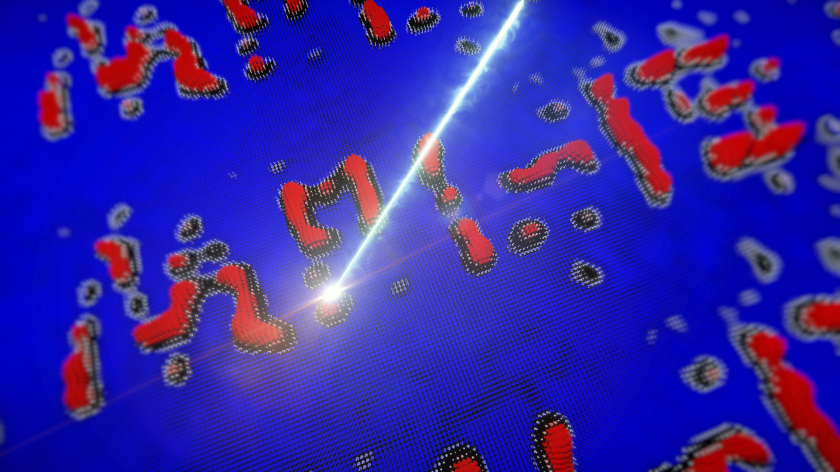New interaction between light and matter discovered at BESSY II

A bundled soft X-ray beam with a diameter of less than 50 nanometers writes numerous magnetic vortices, which together form the term "MPI-IS". © Alejandro Posada, Felix Groß/MPI-IS
A German-Chinese team led by Gisela Schütz from the MPI for Intelligent Systems has discovered a new interaction between light and matter at BESSY II. They succeeded in creating nanometer-fine magnetic vortices in a magnetic layer. These are so-called skyrmions, and candidates for future information technologies.
Skyrmions are 100 nanometre small three-dimensional structures that occur in magnetic materials. They resemble small coils: atomic elementary magnets - so-called spins - which are arranged in closed vortex structures. Skyrmions are topologically protected, i.e. their shape is unchangeable, and are therefore considered energy-efficient data storage devices.
Soft x-rays at BESSY II
In a series of experiments on the MAXYMUS beamline of BESSY II, the researchers have now shown that a bundled soft X-ray beam with a diameter of less than 50 nanometres can generate a magnetic vortex of 100 nanometres. In order to make the skyrmions visible, the researchers use the MAXYMUS scanning transmission X-ray microscope. This is a high-resolution X-ray microscope, weighing 1.8 tons, located at BESSY II.
Serendipitous discovery
This discovery was made by chance, as this type of interaction between light and matter was previously completely unknown. "We don't know how light writes matter," says Dr. Joachim Gräfe, head of the research group Nanomagnonics and Magnetization Dynamics at MPI-IS. He is one of the main authors of the study, which was published in Nature communications in February. "We can describe certain properties phenomenologically. We know that it has to do with the X-ray beam. It's not just an energy input like heat that writes the Skyrmion. It's really a resonant effect: we can directly excite the atoms responsible for magnetism." This enabled him and his team to write "MPI-IS" (see figure).
Outlook: Future Spintronics
The results are particularly relevant for the development and production of so-called spintronic data carriers, which store information in skyrmions. They are considered to be energy-efficient and less susceptible to interference. However, this development can only take its course if skyrmions can be created precisely and with a perfect fit - and this has now become possible for the first time. "Our goal is for X-rays to serve as a tool for determining or writing the arrangement of magnetic structures in the future."
red/MPI-IS
https://www.helmholtz-berlin.de/pubbin/news_seite?nid=21272;sprache=en
- Copy link
-
Battery research with the HZB X-ray microscope
New cathode materials are being developed to further increase the capacity of lithium batteries. Multilayer lithium-rich transition metal oxides (LRTMOs) offer particularly high energy density. However, their capacity decreases with each charging cycle due to structural and chemical changes. Using X-ray methods at BESSY II, teams from several Chinese research institutions have now investigated these changes for the first time with highest precision: at the unique X-ray microscope, they were able to observe morphological and structural developments on the nanometre scale and also clarify chemical changes.
-
BESSY II: New procedure for better thermoplastics
Bio-based thermoplastics are produced from renewable organic materials and can be recycled after use. Their resilience can be improved by blending bio-based thermoplastics with other thermoplastics. However, the interface between the materials in these blends sometimes requires enhancement to achieve optimal properties. A team from the Eindhoven University of Technology in the Netherlands has now investigated at BESSY II how a new process enables thermoplastic blends with a high interfacial strength to be made from two base materials: Images taken at the new nano station of the IRIS beamline showed that nanocrystalline layers form during the process, which increase material performance.
-
Hydrogen: Breakthrough in alkaline membrane electrolysers
A team from the Technical University of Berlin, HZB, IMTEK (University of Freiburg) and Siemens Energy has developed a highly efficient alkaline membrane electrolyser that approaches the performance of established PEM electrolysers. What makes this achievement remarkable is the use of inexpensive nickel compounds for the anode catalyst, replacing costly and rare iridium. At BESSY II, the team was able to elucidate the catalytic processes in detail using operando measurements, and a theory team (USA, Singapore) provided a consistent molecular description. In Freiburg, prototype cells were built using a new coating process and tested in operation. The results have been published in the prestigious journal Nature Catalysis.
